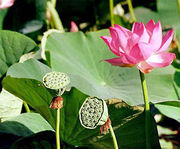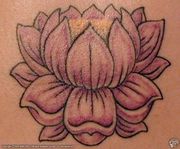Lotus
Holy flower that grows in muddy waters
The lotus flower is said to express "universal laws such as Inter-Dependent Existence, Uncertainty of Life, Cause and Effect, and Purity." While it grows almost exclusively in muddy waters, its leaves and flowers are coated in wax, and it is generally unstained and clean. Other things that make the lotus unusual are that it has both its seeds and flower at the same time, and that it lives for only four days.
Buddhist philosophy says that the lotus was the first flower that bloomed when the world was created, at which point five holy flowers appeared. The Maha Brahma then created five sets of robes from these flowers which were then given to the five Buddhas they represented the enlightenment of. Four have been given out (represented by lotus flowers), and one still remains to be given out (represented by a lotus bud), as that Buddha has not yet achieved enlightenment. Petals of the lotus flower are also used to represent many aspects of the Abhidhamma doctrine (for example, eight for the Eightfold Noble Path, 108 for the 108 attributes of Lord Buddha, and so on).
The lotus flower (padma) also plays a strong role in Hindu mythology. The leaf stands for the ferrite earth, the flower a mother's lap, and the stem the life of water. The bud stands for virginity and the open flower for the sun. In addition, the lotus flower acts as a throne for deities.
In the Hindu creation myth, Vishnu was first sleeping in the coils of a giant cobra on a dark ocean. He was awakened by a thundering Om, and as dawn broke, a lotus flower formed in his navel. In the middle of this flower was Brahma (Vishnu's servant). Vishnu said to him, "it is time to begin -- create the world." Vishnu and the snake disappeared, and a giant wind lifted the ocean. Brahma remained on the lotus flower floating on the sea. He calmed the winds, and broke the lotus flower into three pieces, with one part becoming the heavens, one part the earth, and the last part the skies, and from this the world was created.
Finally, lotus flowers are also used extensively as decorative and iconographic devices in Buddhist and Hindu temples and architecture.
This is a basic overview which may or may not be 100% correct. As always, more research is encouraged.


